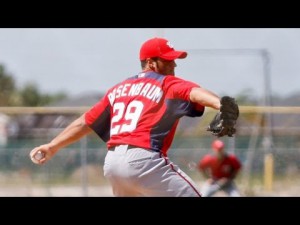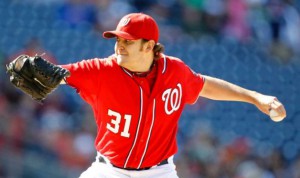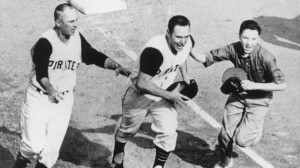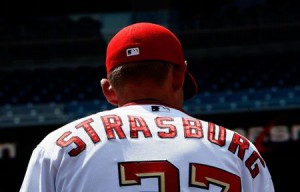
Harper has turned into a very good defensive CF. Photo Gary Vasquez/US Presswire via Natsinsider.com
Jim Bowden was the latest pundit to repeat the often-mentioned mantra “The Nats need a Center Fielder,” but this isn’t entirely a “pick on Jim Bowden” post. Most pundits think the Nats are still in love with BJ Upton or newly in love with Michael Bourn and will aggressively pursue one or the other this coming off-season. Now, that tired statement may have been true in the 2011 off-season, but anyone who still prints this now hasn’t been watching what has been going on in the Nats outfield this season.
To put it simply; Bryce Harper has turned into a very good defensive center fielder. And there’s no reason to move him off the position for a number of years.
It only took about a week for rumors of Harper’s arm to circulate around the league; within a week or so 3rd base coaches were already playing it conservatively and refused to challenge his arm. It only took a couple of Sportscenter highlight throws from the outfield to earn that praise. Harper has 3 outfield assists on the year and probably won’t get too many more given the reputation he’s already earned.
But his arm is just one part of the equation. Click here for the advanced fielding measure “UZR/150” for all 2012 center-fielders with at least 500 innings played. Harper currently possesses a 28.6 UZR/150, good for 2nd in the league and far above vaunted defensive outfield wizard (and fellow Rookie phenom) Mike Trout. In fact, he’s just ahead of Bourn and only behind reserve outfielder Craig Gentry. To put this into english; right now Harper is just about the best defensive center field in the league. He’s very fast, shows great range on the ball, and his errors have generally been on over-aggressive throws instead of dropped balls.
By way of UZR/150 comparison, Bourne is clearly a top defender, but the other rumored target Upton actually boasts a -1.3 UZR/150 right now, indicating that he’s actually costing his team runs.
The common narrative is that the Nats want a lead-off/center fielder type so they can move Harper to one corner and Jayson Werth the other and have a plus outfield all the way around. But lets face it; that’d be a monumental waste of Harper’s defensive talents right now. An .850 OPS hitting center fielder with 30 homer capabilities is one of the rarest commodities in baseball, and usually good ones only come around once in a generation. We already knew Harper was such a generational talent, but even I was surprised to see just how well statistically he has played CF thus far. Do the Nats need a prototypical lead-off hitter? Yes …. but not as long as Werth is willing to be in that role. Here’s a fact; Werth has an OBP of .426 hitting lead-off this year, which would be the 2nd best OBP in the league (behind the amazing Joey Votto) if he qualified. When you have almost an entire lineup of guys who have 20-hr power, someone has to bat lead-off.
The other problem with the “Nats get a free agent CF” scenario is that it leaves no room in the outfield for Michael Morse. Buying another outfielder pushes Morse to 1B, which pushes Adam LaRoche out the door. Now, this scenario may happen regardless (LaRoche absolutely should parlay his 2012 season into a multi-year FA deal, or at least explore the possibility), but I’d rather have the positional flexibility to give someone like Tyler Moore more starts, or to give the resurgent Roger Bernadina starts against right-handed starters, or even keep LF the rotating door between Moore, Bernadina and Lombardozzi so that all three valuable players can get playing time. And if you don’t think the team really wants to give Moore playing time, then you havn’t been paying attention to his season.
Lastly there’s this: spending money on an unneeded CF means less money to spend on pieces that we WILL need; money towards either Edwin Jackson or his rotational replacement, money towards some bullpen reinforcements, or perhaps money to extend a trade target that we leverage to free up some positional log-jams (middle infield for example, between our current starters and the upper-end reinforcements on the way in the high minors).
There’s been comparisions of Harper to the vaunted Mickey Mantle in the past; if Harper sticks in CF for the next decade, those comparisons will just be all the more viable.



